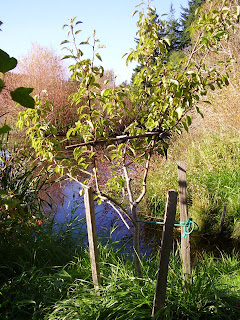Vision
僕のビジョンは、祖国日本で、平和文化を育みポストカーボン(Post-Carbon) 社会を促進してゆく事です。
化石燃料や原子力に頼らず、他国の資源を取らない、
Thursday, May 26, 2011
Village Building Convergence シティリペア村作り集会
Sunday, May 22, 2011
The surreal world....
and I was reminded of how intense life has been since I left Japan for college.
I arrived to the US in 2001, just before 9/11 happened.
Since then,
I have lived in a country openly at war in various middle east countries since.
This country has been actively at war since i got here!
Well, some argue the US has always been at war with some unfortunate country.
what is my connection to this war?
What is my role and responsibility in this?
It's such a bewildering event.
I never thought of war as something that still exists until i came to the US.
After years of updating myself on faraway global disasters around the world through the BBC,
like earthquakes, genocide, invasions, floods, tsunamis, food shortages, assassinations, terrorist attacks, revolutions, etc,
I found myself in Japan during a short 3 months visit,
in the midst of a devastating earthquake,
and a nuclear disaster that has alarmed nations around the globe.
It all feels surreal.
War, nuclear disaster, global climate instability, giant earthquakes,
But, I guess thats life in the modern world.
What a world to inherit....
My current plan is to fly back to Japan to reunite with my partner in August,
and attend grad school in Tokyo to study how to nurture a culture of sustainability.
I occasionally think about how I am committing to life near an escalating nuclear disaster,
in a region that is due for a similar sized earthquake,
Sometimes it feels like I am preparing to die.
It's consoling to know that
Japan is where i would like to return to the earth.
two heavily circulated quotes have recently captivated my mind.
The world we have created is a product of our thinking; it cannot be changed without changing our thinking.
you must be the change you wish to see in the world
Wednesday, May 18, 2011
Grafting II: the next level 接ぎ木2応用編
INTERGENRIC GRAFTING
Not only can you graft different varieties on your pear tree,
you can graft a pear (Pyrus) tree onto the roots of a quince (Cydonia oblonga).
Quince roots can tolerate wet soils that might kill a pear.
We also graft pear varieties onto the hawthorn that volunteer all over the property.
Instead of spending loads of energy removing these pioneering non-native plants,
I had heard a few years ago of the pomato plant.
食と教育の最先端:「実践型教育でサステナビリティーを身につける」
- The Program In Agorecology and Community (PICA) and
- Community Agroecology Network (CAN).....its about coffee!
PICA's primary academic mission is to engage students with sustainability through practical experience and the sharing of community based knowledge. Through seminars, practical training in agroecology and organic gardening, student involvement in campus and community gardens, and the development of local composting projects, PICA students are able to integrate classroom instruction with hands-on learning.
PICAns work in the classroom and the field to address such questions as:
- How do issues of environmental quality and social justice interact in sustainable communities?
- How does an understanding of ecology inform decisions about farming/gardening practices?
- What impact can consumer choice have on how farmers design and manage their farming systems?
- What roles do art and creativity play in shaping social change and in sustaining communities?
Each of CAN’s partner communities is represented by a researcher liaison who has established a long-term relationship with member-based organizations in the community. Together the researcher, organization and farmer members address questions related to sustainable farming systems.
CAN's trade innovations connects small-scale coffee farmer cooperatives, coffee roasters, researcher liaisons, the Santa Cruz Farmer's Market, university dining halls, students and household consumers to create alternative trade models
- NEW! AgroEco Coffee® Initiative is an innovative partnership for sustainable community development between CAN, researcher liaisons, community partners in coffee growing regions and a U.S. based coffee roaster, Santa Cruz Coffee Roasting Company. This initiative builds long-term relationships to support farmers in agroecological stewardship, participatory monitoring, and higher prices for their coffee.
- Coffee from the cooperative in Nicaragua is shipped to Santa Cruz where it is roasted and marketed to consumers
僕の人生を大きく変えた、
教育プログラムについて書きました。
【教育】【生きる事】【サステナビリティー】について、
深く考えさせられた大学プログラム。
この前紹介した
「持続可能な生活の教育学(ESLP)」
の続きです。
日本でもどんどんパーマカルチャーやこういうプログラムを、
広めていきたいです!
私はアグロエコロジーの研究で有名なスティーブ・グリスマン教授(カリフォルニア大学サンタクルス校;UCSC)に、バイオインテンシブ農法を実践型授業で学んで以来、食糧への関心が深まりました。グリスマン教授は、食糧システム、コミュニティー、サステナビリティーを実践型で教育している画期的なプロジェクトの数々に関わっています。畑仕事を主にする(専攻を問わず誰でも受けられる)「ガーデン・インターンシップ」や、「アグロエコロジーとコミュニティーのプログラム(PICA)」や、「コミュニティー・アグロエコロジー・ネットワーク(CAN)」や、『サステナ』第一号でご紹介頂いた「持続可能な生活のための教育プログラム」も彼のサポートの元で学部生が立ち上げたものです。
アグロエコロジーとコミュニティーのプログラム(PICA)
PICAは「生活」を実践型教育の媒体とし、バイオインテンシブ・ガーデンを取り巻いて、サステナビリティーとコミュニティーについて学び合うプログラムです。学部生、スタッフ、教授が一緒に食べ物を育て、一緒に食事をし、コンポストを行い、生活の場をデザインして開拓し、密接な共同生活で現れる問題解決に取り組みます。サステナビリティーのあらゆる要素を学生中心のゼミで話し合い、校内に設けられた専用のガーデン付きの寮を中心としたエコ・コミュニティー内で生活を営みます。専攻を問わず大学の敷地内にあるPICA専用の寮に応募する事ができ、またPICAに住まなくてもゼミだけを受けたり、ガーデンでボランティアだけ参加する事も出来ます。最近は工学部や地域のエコビジネスと連携して、テクノロジーを駆使したモデル施設を目指しているようです。
コミュニティー・アグロエコロジー・ネットワーク(CAN)
CANは、珈琲を中心に中米の生協農家、先進国(米国)の消費者、学生と教育者を繋げる国際ネットワーク・プログラムです。研究と教育を通して珈琲生産をエコロジカルに行いつつ、もろい環境に置かれている中米の珈琲農家の生活保護も新しい形でのグローバリゼーションを通して現実化しているのです。生産者と消費者の距離を短くする事によって、農家には今流行りのフェアトレード以上の収入が確保されるのです。学生は一学期間中米の農家とホームステイをして現地の人と働きながら研究を行う事も出来ます。地域のファマーズ・マーケットやUCSCのあらゆるカフェなどでは主にCANの珈琲が販売されており、持続可能な生活の為の教育プログラムでは、中米の珈琲農家の方々、ホームステーした学生、及び食糧システム研究員からなるパネルがほぼ毎年行われています。
農生態学・持続性食糧システムセンター(CASFS)
これらに先駆けてグリスマン教授が手掛けた大規模なプロジェクトに、「農生態学・持続性食糧システムセンター(CASFS)」があります。
CASFSのミッションは、研究、実践、活動を通して環境に優しく、経済的に成り立ち、社会的に公正であり、非搾取的な食糧/農業システムを開発推進していく事です。学生、教授、研究者、スタッフ、NGO、一般の方々、農家、政府と共同で活動に取り組んでいます。研究と教育の現場、10ヘクタールの農場と1.2ヘクタールの農林菜園には、年間数千人が世界中から訪れるそうです。
ここで行われている企画の一つで、国際的に認識されているものに1967年から行われてきた独立小農民を目指す者の為の、住み込み有機農業研修プログラムがあります。研修生は文字通り、半年間農場に住み込んで農園を維持し、農生態学やマーケティングの講義を受け、独立小農民に必要とされる知識と技術を実践を通して学んでゆきます。プログラムの維持費の一部は、研修生らによる「地域に支援された農業」(CSA)というアメリカ流産直商法(生協のようなもの)や直売にて賄われています。研修生は食生活を分ち合い、共同生活を営むにあたり現れてくるコミュニティーの問題を民主的に解決したり、各々の専門分野における知識を教え合ったりします。農家を目指す人だけでなく、シェフや教育者、発展途上国で活動している者、又NGOで働く者等、背景は様々なようです。
ここで学ぶ事が出来るユニークな農法は、アラン・チャドウィック氏が伝授した仏インテンシブ・バイオダイナミック農法から発展したバイオインテンシブ農法です。殆ど外部からは資源を持ち込まず(肥やし等)、機械も使わず、手作業で多種多様な一年草や多年草の花、野菜、果樹を交えて安定した環境システムを維持しながら、小さな土地で最大限に地域に適切な産物を育てています。冬の間も休閑せず、空豆、オーツ、ベッチなど土の栄養補給や春のコンポスト材料に有効な植物が植えられます。
この他、夏の短期間コースや国際出張コース等も行われます。また、研究農場の一部では「ライフラボ」と称される自然体験教室が催され、子供達に環境システム、食、農業について教える場となっています。ライフラボは実に独創的にデザインされていて、かわいらしい丸い畑、断面が覗ける仕組みの蜂の巣、木の中の音楽室、変わった鶏のいる鶏小屋、様々なコンポスト等、あらゆる要素満載の楽しい学びの空間は子供だけでなく大人にも大人気です。
これら大学で行われているプログラムの共通点は、「食」とコミュニティーを中心に実践を通して学び、専攻を問わず皆に提供されている事です。
今の世代が抱えている課題は、これからの時代をどう生きるかです。サステナビリティーは生活を実験台に身につける必要があるのではないでしょうか。このように専攻の制限を超越した生きた教育が、最先端を進む大学や世界中で活躍している草の根パーマカルチャーセンター等で、今後もっと実践されてゆくことを願っています。
Tuesday, May 17, 2011
5/17 アップデート速報
研修生生活が忙しくなってきたので、
錆びてしまった日本語力を使うのが大変です。
頑張らないと。
はっぴ〜ラブモンスタ〜編集ありがとう!
Thursday, May 5, 2011
The Good Life: an eventful April パーマカルチャー生活4月の様子
沼の向こう側から見たブロックス・パーマカルチャー・ホームステッドのゾーン1と2。
クリックすると拡大します。
苗木セール
林檎、桃、プラム、梨、シポーバ、杏、スモモや
ブルーベリー数種類をベアルート(裸根)で提供しました。
ベアルート、つまり鉢も土もない植物だけで買った方が、
低価格で、運びやすい形で欲しい樹木を手に入れる事ができます。
4月の最後、
残り少ない野菜でニコがご馳走を準備しています。
この時期に使える材料は根菜(ごぼう、芋、ヤコン、ビーツ、人参、かぶ、ルタバガ、パースニップ)、
林檎と新鮮ケールでした。
結構色々選択肢があるものです。
冬でも食べ物で盛り上がっています。
半地下貯蔵室
ピクルス、手作りソース、色んな果物のジャム。
下と右の方でごぼうがいっぱい芽を出しています。
写真はルート・セラー(野菜貯蔵室)で隣にフルーツ・セラー(果物貯蔵室)があります。
エチレンガスの関係で根菜と果物を別々にするらしいです。
ゆりこ、マリア、C8が苗用の土を混ぜている所です。
会話を楽しみながら作業をするのがここの特徴だと思います。
【遊働】
新しい研修生の為にダグがツアーを行っている様子です。
二つのポリハウスにはワシントン州では珍しい植物が共生しています。
僕が個人的に興味を持っているものは、
ネクタリン(実が沢山なっています)、ヤポンノキ(耐寒性マテ)、お茶、ビワ(寒すぎて殆ど実がなりませんが)、猿梨、多年草ブロッコリー、オリーブ(実る事は無いです)、山葵、キクイモ、ヤコンなどです。
ポリハウスのフレームになっているPVCパイプはポリエチレンと化学反応をおこさない様にペンキでコーティングされています。床にはシートマルチとして、捨てられていたカーペットを敷いています。裏側に敷くので帚で掃除もしやすいです。両側にドアがあり温度を手で調節します(天気によっては大変なときもあります)。また受粉してくれる虫達を誘う為にも開けたりします。アクセスしやすくする為にゾーン1(キッチン、アロハロッジ)のすぐ側に配置されています。
やっと春のガーデニング!
あらゆる種類のレタスが植えられています。
数週間後にはポリハウスに変身してトマトが植えられます。
トマトの為には苦労を惜しまないもんやで~
元自然体験ガイドのDaveがダグのツアーに引き戻してくれます。
こんどはダグの家の近くの林檎ギルドのお話です。
この気候に最適な林檎、ヒレハリソウ、スイセン、チューリップ、妖精のギルド。
美しくて、コンパクトで、機能的な共生関係。
奇跡の林檎の著者、木村あきのりさんが育てているギルドはどういう物なのでしょうか?
興味があります。
気候が違うと色々変わもんやな。
因にオーカス島はカリフォルニアのように地中海気候です。
キッチンのお引っ越し。
温室から野外へ移ります。
春へのトランジション。
これからが楽しみや~.
解放感が格別です。
新しい生活の始まりです。
夏のお祭りの準備をしている様な気分がします。
一種の模様替えです。
ダグが怪しいポーズをとっている間に
プラスチックの屋根が上がります。
雨の行方をコントロールするため、
排水溝も設置しました。
バケツの中には穀物、豆、砂糖などが入っています。
毎日肉体労働をしていて、
寒い中、野外で寝ているから、
エネルギー消費はすごいです。
そのエネルギー補給の為に食べ物はいつもいっぱいあります。
どうしても安くて便利なプラスチックが目立ちます。
減らしたいのですが
そう簡単には行きません。
家具が配置されキッチンと雨の日用ダイニングの完成です。
いよいよ春の生活が始まります。
今年はやたら寒いです。
ちょっと野外ではたまにきつい感じがします。
一番遠いガーデンの土を調べています。
タマネギを植える予定ですが,
まだぬれすぎているようです。
今年は中々晴れへんねん。
なんでや〜!
温室でサイモンがパソコンをバラバラにして直しています。
ここに来る人は色んなスキルをもっていて、
たびたび感動させられます。
何でも屋のコミュニティー。
まさに【半農半x】ですね。
もしかしたら【半農半xxxx】かもしれません。
ガーデンのオリエンテーション
ジェームズとC8が冬の間に計画してくれた
ガーデンデザインの説明をしてくれました。
わくわくしますね。
ゆりこさんの家で日本的な食事。
食材の質だけではなく、
最終的な味と、
見た目も大切ですよね.
この日は中華でした。
いつも美味しくて、食べ過ぎしまいます。
変に食文化になると日本プライドがでてきます。
ジェーンが道具の整理をしてくれました。
道具の物置小屋は本道の中心におかれています。
大抵ゾーン1から作業場に向かう時、
道具が必要になるので、
(必ず通る)便利な所に配置されています。
ニコが新しいコンポストの作法を説明しています。
イエロー・エッグ・プラム(すごく美味しいそうです)の
木のふもとに作り立てのコンポストがあります。
ニコの後に、サムが左下に見える様々な農業道具の説明をしてくれました。
正しく道具を使うのは大切ですよね。
(寒い)地中海気候のここでは夏の間、灌漑が必要です。
Daveが灌漑システムの組み立て方と、
メンテナンスの説明をしてくれました。
サムが機械の説明をしています。
草刈り機を紳士のように押しながら、
安全な扱い方を冗談をふんだんに交えながら教えてくれました。
デーブは草刈り機をトランジショナル・テクノロジー・マルチ製造機と呼びます。
修理、メンテナンス、安全、機械を長生きさせる為の工夫などを学びました。
昔ながらの農家のように、
ブロックスは色々な部品を他所で拾ったり、
機械を組み合わせたり、
道具を造ったりします。
かっこいいですね~。
サムが三種類の燃料の特徴と使い分け方を説明しています。
ここで使うのは「バイオデーゼル」、「ガソリン」と「チェーンソー」などに使う「ツーサイクルミックス(ガソリンとオイル)」。
復活祭のイースターエッグ探しをしています。
色々な機械の話でだんだん限界を感じていた研修生には
ナイスタイミングなイベントでした。
ゆりこさんが卵に色を塗って、
ガーデンのあらゆる所に隠しました。
彼女はみんなが真剣に取り組んでいる所を見ながら、
いつものように笑っていました。

ちょっとずつガーデンに野菜が植えられています。
C8はこの日スナップエンドウの苗を植え始めました。
数時間でスナップエンドウの大都市の完成。

サイモンが作業ベンチを作っています。
捨てられた家具が土台となりました。
ここではみんなが捨ててしまう物を集めて、
直したり、新しい物を作ったり、時にはそのまま使います。
【ゴミ】とは見捨てられた資源なのです。
消費文化のリーダー日本は、
もしかしたら世界一質の良い【捨てられた資源】の持ち主かもしれません。
宝島ジパング。
ここと現代社会の大きな違いの一つは、
生産者と利用者の距離です。
ブロックスでは殆どの場合利用者と生産者の違いがありません。
だから壊れたら直す事もできるし、
使いながら調整したり、
改造したりもできます。
専門家に頼る必要の無い、
自立した生き方。
木登り好きのジェーンがかっこ良く剪定をしています。
自然の中で子供みたいに楽しみながら働く事は大切ですよね。
これ以上健康的で楽しい仕事はあるのでしょうか?
新しいミツバチの巣を箱に移している様子です。

箱の中にはものすごい量の蜂が詰め込まれており、
女王蜂はさらに小さな箱の中で隔離されています。
(なんで日本語の説明こんなに少ないねん!)

ごぼうの間引き。
ハワイではこうやってドラム缶の中でごぼうを育てるそうです。
収穫がしやすく、大きな牛蒡を育てる事ができます。

リリが車の修理に挑戦。
新しいクーラント・バイパス・ホースを取り付けています。
意外と時間がかかりました。
ブロックスは自分たちの車をしょっちゅういじっています。
彼らが育った時代は車を自分で整備するのが当たり前だったのはないでしょうか?
お金がなかったのも大きな要素だと思います。
社会が金銭的に裕福になるにつれ、
このようなスキルが失われてしまうのでしょうか?

芋植え。
今年は今の畝を減らして、
タマネギを増やす事にしました。
秋には研修生がいなくなるので、
収穫の早いレッド・ノーランドを多めに植えました。
他にはジャーマン・バターボール(めちゃめちゃ美味しい)、パープル・バイキング(中まで紫色)、オーストリア・クレシントなども育てます。
堀の中に芋を並べて、
土で軽く被せました。
芽が伸びるとともに、
土で被せていきます。
鶏の移動をカメラクルーが撮影しています。
【百姓ライフ】農系リアリティー・テレビ番組。
流行るかもしれませんねー。
上は嘘で、実はワカン・タンカというドキュメンタリーの撮影中なのです。
彼らはドキュメンタリーを通して、環境・平和活動の【エルダー】(長老)から若者へのメッセージを
伝えたいそうです。
ブロックスはサステナビリティー生活の実践モデルの一つの例として、
撮影される事になったのです。
撮影の一部に
各研修生からのメッセージが撮られました。
お題:
一言であなたはどのようにサステナビリティーを実践していますか?
Wednesday, May 4, 2011
Beauty of April 心を育む春の美


大山査子










































